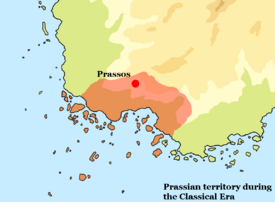Dassaria
Dassardaemon Δασσαρδαίμων (Ancient Piraean) | |||||||||
|---|---|---|---|---|---|---|---|---|---|
| 700s–210 BC | |||||||||
 Territory of ancient Prassos before 217 BCE | |||||||||
| Capital | Prassos | ||||||||
| Common languages | Ancient Piraese | ||||||||
| Religion | Piraese polytheism | ||||||||
| Government | Oligarchical stratocratic constitutional monarchy | ||||||||
| King | |||||||||
• c. 930–900 BC | Agis I | ||||||||
• 217–210 BC | Nabis | ||||||||
| Legislature | |||||||||
| Historical era | Classical antiquity | ||||||||
| 700s BCE | |||||||||
| 448-415 BC | |||||||||
| 272-259 BCE | |||||||||
• Consolidation | 250 BCE | ||||||||
| 217 BCE | |||||||||
| 210 BCE | |||||||||
| |||||||||
Prassos was a prominent kingdom in ancient Piraea, today a part of Daksar in modern-day Austeria. In antiquity, the city-state was known as Dassardaemon, (Δασσαρδαίμων, Daksardaímōn), while Prassos referred to the river valley the eponymous settlement was built on. It was the last major Classical Piraese power before the region's conquest by the Solarians in 210 BCE.
Prassos emerged from settlements founded by colonists from the city-state of Aptera in Austeria around 731 BCE. The colony formed a crucial part of Aptera's struggle with its historical rival Lasithi, by providing soldiers and arms to its overlord. In 430 BCE during the Sitia War (448 - 415 BCE), Prassos rebelled against Aptera and sided with Lasithi and the alliance it led. Following the conclusion of the war, Prassos became independent, albeit under the hegemony of Lasithi. Prassos participated in several rebellions against Lasithi, for which it was sacked numerous times. Following the eruption of the Juktas and the War of the League of Maleme (272 - 259 BCE) Prassos defeated Lasithi and emerged as the predominant Piraese state. In 250 BCE, Prassos incorporated the members of the league, forming the first unified political entity in Piraese history.